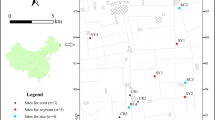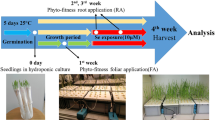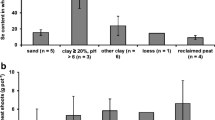Abstract
This two-part study compared the efficacy of different plant species to extract Se from soils irrigated with Se-laden effluent. The species used were: Brassica napus L. (canola), Brassica juncea Czern L. and Coss (Indian mustard), and Hordeum vulgare L. (barley). In Study 1 we irrigated the plants with a saline effluent containing 0.150 mg Se L−1, while in Study 2, the same species were planted in a saline soil selenized with 2 mg Se L−1. Plants were simultaneously harvested 120 days after planting. In Study 1, there were only slight effects of treatment on dry matter (DM) yield. Plant Se concentrations averaged 21 μg Se g−1DM for the Brassica species, and 4.0 μg Se g−1 DM for barley. Total Se added to soils via effluent decreased by 40% for Brassica species and by 20% for barley. In Study 2, total DM decreased for all species grown in saline soils containing Se. Plant Se concentrations averaged 75 μg g−1 DM for Brassica species and 12 μg Se g−1 DM for barley. Total Se added to soils prior to planting decreased by 40% for Brassica species and up to 12% for barley. In both studies, plant accumulation of Se accounted for at least 50% of the Se removed in soils planted to Brassica and up to 20% in soils planted to barley. Results show that although the tested Brassica species led to a significant reduction in Se added to soil via use of Se-laden effluent, additional plantings are necessary to further decrease Se content in the soil.
Similar content being viewed by others
References
Anderson J W and Scarf A R 1983 Selenium and plant metabolism. In Metals and Micronutrients: Uptake and Utilization by Plants. Eds DA Robb and WS Pierpoint. pp 241–275. Academic Press, New York, NY.
Ayars J E, Hutmacher R B, Schoneman R A, Vail S S and Pflaum T 1994 Long term use of saline water for irrigation. Irrig. Sci. 14, 27–34.
Baker A J M, McGrath S P, Sidoli C M D, and Reeves R D 1994 The possibility of in situ heavy metal decontamination of polluted soils using metal-accumulating crops. Res., Conser. Recycl. 11, 41–49.
Bañ uelos G S, Meek D W, and Hoffman G J 1990 Effect of selenium, salinity and boron on selenium accumulation by wild mustard. Plant Soil 12, 201–206.
Bañ uelos G S, and Meek D W 1990 Accumulation of selenium in plants grown on selenium-treated soil. J. Environ. Qual. 19, 772–777.
Bañ uelos G S, Dyer R, Ahmand R, Ismail S, Raut RN and Dagar JC 1993 In search of Brassica germplasm in saline semi-arid and arid regions of India and Pakistan for bioremediation of selenium laden soils. J. Soil Wat. Conser. 48, 530–534.
Bañ uelos G S and Akohoue S 1994 Comparison of wet digestion and microwave digestion on selenium and boron analysis in plant tissues. Commun. Soil Sci. Plant Anal. 25, 1655–1670.
Bañ uelos G S 2000 Factors influencing field phytoremediation of selenium-laden soils. In Phytoremediation of Trace Elements in Soils and Waters. Eds N Terry and GS Bañ uelos. pp 41–60. CRC Press, Inc. Boca Raton, FL.
Cervinka V 1994 Agroforestry farming system for the management of selenium and salt on irrigated farmland. In Selenium in the Environment. Eds WT Frankenberger Jr. and S Benson. pp 237–250. Marcel Dekker, Inc. New York, NY.
Chaney R L 1983 Plant uptake of inorganic waste constituents. In Land Treatment of Hazardous Wastes. Eds JE Parr, et al. pp 50- 76. Noyes Data Corp., Park Ridge, NJ.
Chaney R L, Brown S L, Homer F A, Li Y M, Baker A J M, and Angle J S 1994 Hyperaccumulators: How do they differ in uptake, translocation and storage of toxic elements. Abstract for Dept. of Energy Workgroup on Bioremediation/ Phytoremediation. July 24- 26, Santa Rosa, CA.
Ernst WHO 1988 Decontamination of mine sites by plants: An analysis of the efficiency. In Proceedings on International Conference on Environmental Contamination (Venice), Italy. CEP Consultants. pp 305–310 Ltd. Edinburgh, Scotland.
Ferryeyra R E, Aljaro A U, Ruiz R S, Rojas L P, and Oster J D 1997 Behavior of 42 crop species grown in saline soils with high boron concentrations. Agric. Wat. Manag. 34, 111–124.
Fiskesjö G 1979 Mercury and selenium in a modified allium test. Hereditas 91: 169–171.
Frankenberger Jr. WT, and Karlson U 1994 Microbial volatilization of selenium from soils and sediments. In Selenium in the Environment. Eds WT Frankenberger Jr. and S Benson. pp 369–389. Marcel Dekker, Inc., New York, NY.
Frankenberger Jr. W T, and Karlson U 1988 Dissipation of soil selenium by microbial volatilization at Kesterson Reservoir. Report, US Department of the Interior, Bureau of Reclamation, Contract No. 7-FC-20-05240.
Guo L, Frankenberger Jr. W T, and Jury W A 1999 Evaluation of simultaneous reduction and transport of Se in saturated soil columns. Wat. Resour. Res. 35, 64–669.
Kabatu-Pendias A and Pendias H 1984 Elements of Group VI. II. Selenium In Trace Elements in Soils and Plants. Eds A. Kabatu-Pendias and H. Pendias pp 185–189. CRC Press, Inc. Boca Raton, FL.
Kumar N, Dushenkov V, Motto H and Rasken I 1995 Phytoextraction: the use of plants to remove heavy metals from soils. Environ. Sci. Tech. 29, 1232–1238.
Lewis B J 1976 Selenium in biological systems and pathways for its volatilization in higher plants. In Environmental Biogeochemistry. Ed. JO Nriagu. pp 389–409. Ann. Arbor Science, Ann Arbor, MI.
Martens D A and Suarez D L 1997 Selenium speciation of soil sediment determined with sequential extractions and hydride generation atomic absorption spectrophotometry. Environ. Sci. Technol. 31: 171–177.
Masscheleyn P H, Delaune R D, and Patrick Jr. W H 1991 Arsenic and selenium chemistry as affected by sediment redox potential and pH. J. Environ. Qual. 20: 522–527.
McGrath S P, Sidoli CMD, Baker A J M, and Reeves R D 1993 The potential for the use of metal-accumulating plants for the in situ decontamination of metal-polluted soils. In Integrated Soil and Sediment Research: A Basis for Proper Protection. Eds JP Eysakers and T Hamers. pp 673–676 Kluwer Academy Publishers, Dordrecht, The Netherlands.
Ohlendorf H M 1989 Bioaccumulation and effects of selenium in wildlife. In Selenium in Agriculture and the Environment. Ed. LW Jacobs. pp 133–177. SSSA Special Publi. No. 23. American Society of Agronomy and Soil Science Society of America, Madison, WI.
Parker D R and Page A L 1994 Vegetation management strategies for remediation of selenium contaminated soils. In Selenium in the Environment. Eds WT Frankenberger Jr. and S Benson. pp. 327–342 Marcel Dekker, Inc., New York, NY.
Rhoades J D, Bingham F T, Letey J, Dedrick A R, Bean M, Hoffman G J, Alves W J, Swain R V, Pacheco P G, and LeMert R D 1988 Reuse of drainage water for irrigation: results of Imperial Valley Study. I. Hypothesis, experimental procedures and cropping results. Hilgardia 56(5), 1–16.
SAS Institute, Inc. 1988 SAS/STAT User's Guide, Release 6.03 edition, Cary, NC.
Shannon M C, Suhayda C G, Grieve C M, Grattan S R, Francois L E, Poss J A, Donovan T J, Draper J H, and Oster J D 1997 Water use of Eucalyptus camaldulensis, clone 4544, in saline drainage reuse systems. Report No. 2 California Department of Water Resources, Sacramento, CA.
Shennan C, Grattan S R, May D M, Hillhouse C J, Schachtman D P, Wander M, Roberts B, Tafoya S, Burau R G, McNeish D, and Zelinski L 1995 Feasibility of cyclic reuse of saline drainage in a tomato cotton rotation. J. Environ. Qual. 24, 476–486.
Terry N and Zayed A M 1994 Selenium volatilization by plants. In Selenium in the Environment. Eds WT Frankenberger Jr. and S Benson. pp 343–369. Marcel Dekker, Inc. New York, NY.
Terry N and Zayed A M 1998 Phytoremediation of selenium. In Environmental Chemistry of Selenium. Eds WT Frankenberger Jr. and RA Engberg. pp 633–656. Marcel Dekker, Inc., New York, NY.
University of California Salinity/Drainage Program 1993 Annual Report. WRC Prosser Trust. Center for Water and Wildland Resources. Division of Agriculture and Natural Resources, University of California.
Van Schilfgaarde J 1990 Irrigated agriculture: Is it sustainable. In Agricultural Salinity Assessment and Management. Ed. KK Tanji. pp 584–594. ASCE Manuals and Reports on Engineering Practices 71. Am. Soc. Chem. Eng. New York, NY.
Wu L, Bañ uelos G S, and Guo X X 2000 Changes of soil and plant tissue selenium status in an upland grassland transformed from a wetland habitat ten years after contaminated by selenium rich agricultural drainage sediment. J. Ecotoxicol. Environ. Safety (in print).
Zayed AM, Lytle C M and Terry N 1998 Accumulation and volatilization of different chemical species of selenium by plants. Planta 206, 284–297.
Zhang Y Q, and Moore J N 1997 Environmental conditions controlling selenium volatilization from a wetland system. Environ. Sci. Technol. 31, 511–519.
Rights and permissions
About this article
Cite this article
Bañuelos, G., Zambrzuski, S. & Mackey, B. Phytoextraction of selenium from soils irrigated with selenium-laden effluent. Plant and Soil 224, 251–258 (2000). https://doi.org/10.1023/A:1004881803469
Issue Date:
DOI: https://doi.org/10.1023/A:1004881803469




